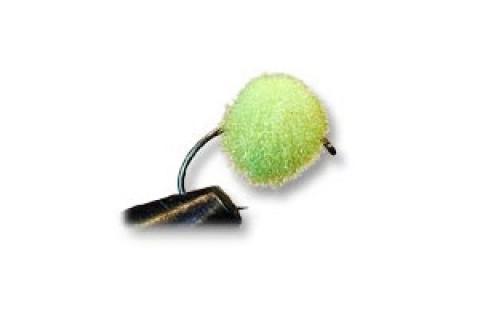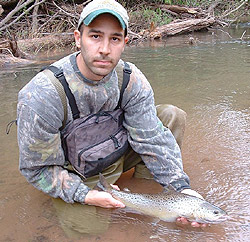
In the fall season, many changes in the environment have begun to take place — especially in the rivers and streams. Subtle cues such as water temperature, level and clarity trigger a massive migration of fish to start returning home to the streams where they where born to repeat the spawning process. It is this spawning process and the returning fish that are of importance to the educated fly angler, seeing as some of the best fishing can come during this time of year. Not just any type of fishing works during this fall run of fish.
 The lake-run salmon and trout and the river residents have a particular interest in eating fresh eggs from their brethren. Presenting egg flies to fish that have ventured up into the rivers can provide a very exciting day of fishing. It might seem so simple but the truth is natural eggs that come from spawning fish make up a more than substantial percentage of the seasonal food base in streams for foraging trout and salmon species.
The lake-run salmon and trout and the river residents have a particular interest in eating fresh eggs from their brethren. Presenting egg flies to fish that have ventured up into the rivers can provide a very exciting day of fishing. It might seem so simple but the truth is natural eggs that come from spawning fish make up a more than substantial percentage of the seasonal food base in streams for foraging trout and salmon species.
Pre-spawn fish are able to set themselves in a downstream position from other spawning fish and forage aggressively on eggs that happen to wash out or be knocked out of the spawning beds. These eggs contain many of the basic nutrients for sustaining life, such as high amounts of protein and carbohydrates that will help to fatten fish quickly.
Egg fishing for trout and salmon may sound relatively simple but be warned; you should expect to lose large number of flies due to snagging up on the river bottom or foul-hooking fish. Often the best presentation requires getting your fly right in the thick of things meaning bouncing off the bottom all the way down the river for long stretches. It can be very frustrating to the beginning fly angler trying to decipher between the current and rocks pulling on your fly and the soft strike of a weary fish.
 |
| Egg fishing for trout and salmon may sound simple but you should expect to lose large number of flies due to snagging up on the river bottom or foul-hooking fish. |
Fly Tackle Considerations
Egg pattern fly fishing can be done with just about any ordinary rod or reel but a few specific equipment adjustments can be made to allow the angler to better fish the techniques needed for these specific flies. Ideally any 8 1/2- to 9-foot 6-weight fly rod and floating line will be adequate for fishing this technique on most waters while heavier rods can be used if fishing rivers that are known for having large, tough-fighting fish. Fishing leader lengths should be tailored to the size of the river you are planning on fishing. Leaders of 9 foot are great for most waters while 7 1/2-foot leaders are good for smaller streams. Stout fly tippets should be used to resist the shock of fighting fish on a taught line.
Detecting Strikes
If you always keep in mind the golden rule that the indicator should be downstream of the fly and be fairly tight to the weight and fly then you can start to apply it to different situations. One of the most important aspects to fishing with egg flies is your indicator system. Egg flies, like nymphs, are dead-drifted downstream, so being able to quickly detect strikes from fish will increase your odds of landing good numbers of fish. Ideally, having an indicator made from bright-colored, high-floating foam is what you are looking for but putties and yarn can also be adequate with shallower water conditions.
Detecting strikes from fish is a combination of watching the indicator and the behavior of the fish at the same time (given you can see the fish working the bottom). In most instances, takes from large fish will be obvious, with the fish moving off of the bottom to where the fly is drifting and sucking down the indicator aggressively. In other cases the indicator won't move as you pass the fishes position but you visualize the fishes mouth actively eating objects floating downstream or you will simply see a tick or slowing down of the indicator giving you just enough info to set the hook before the fish spits your egg fly. Paying close attention to each drift and how your fly line is drifting will pay off in the long run. The biggest fish seem to always be the ones that suck in egg flies softly barely tipping you off to their presence on your line.
Egg Pattern Fishing Techniques
To fish egg patterns a fly angler should be well versed in the art of dead drifting nymphs, seeing as this technique will be very similar. The basic cast that is used to present flies to fish is the "3/4 up and across the current cast." This cast will land the fly upstream of your potential target so that it does not spook weary fish and allows the fly the proper amount of time to sink to the required depth. As the egg fly tumbles downstream the angler should gather the slack line and keep the rod tip following the indicator downstream. As the fly comes to a position downstream, slowly lift the rod tip and allow the fly to swing out of the current. Take a few steps upstream and repeat this process until you have covered the entire hole.
With this type of up-and-across presentation, ideally the fly should land upstream of the indicator on the cast. If you are able to do this consistently you will be able to see if a fish strikes your fly early in the drift. If the fly happens to land downstream of the indicator the fly will start to sink to the bottom and you would not be able to see any signs of a strike until the line and indicator become tight downstream of the fly.
 Cast lengths are always a popular question with fly anglers. You should use as long of a cast as you can properly handle upstream without letting excess slack build up in your presentation of the flies. A good idea is to position yourself near the head of the long run of riffle and allow your flies to long-line drift the entire run downstream of your position. Too much line upstream of the angler makes it hard to set the hook on strike from fish but if your line is downstream of your position and in the current you should still have good control and feel over your fly.
Cast lengths are always a popular question with fly anglers. You should use as long of a cast as you can properly handle upstream without letting excess slack build up in your presentation of the flies. A good idea is to position yourself near the head of the long run of riffle and allow your flies to long-line drift the entire run downstream of your position. Too much line upstream of the angler makes it hard to set the hook on strike from fish but if your line is downstream of your position and in the current you should still have good control and feel over your fly.
For this long drift use the standard up-and-across cast into the fast current and allow the fly to drift naturally downstream. As the fly reaches a point directly in front of you lightly lift the line off the water (trying not to disturb the indicator) and place an upstream mend into your line while continuously feeding line. With a little practice you get the hang of feeding slack into the drift without disrupting the indicator you can get some very long drag-free drifts.
These long drifts can be very effective seeing as your fly stays in the fish's strike zone for extended periods of time. To set the hook with egg flies, fly anglers should perform a simple sweep and set with the fly rod. This sweep and set is accomplished by sweeping the rod low and to the side (watching for brush or your fishing partner) followed with a quick stout hook-set at the end of the sweep. In this case the flowing current along the body of line will create enough tension for you to set the fly in the fish's mouth.
A good point to remember when egg fishing, just as with nymph fishing, is that if a fish has taken your fly — set the hook. It is much easier to deal with losing a fly then a trophy fish because you did not set the hook in a timely fashion.
Egg Fly Fishing Considerations
The eggs from spawning fish in the river may come in many different sizes and colors. Eggs from spawning rainbow trout are approximately 3/16 inch in size and can be characterized with a translucent yellowish-orange color. Spawning steelhead and Coho salmon produce almost identical eggs that are about a 1/4 inch in size and basically have the same translucent yellowish-orange color seen in rainbows.
Chinook salmon eggs produce similar colored eggs to the other mentioned species but have a slightly larger size at 3/8 inch. Brown trout have eggs that are roughly a 1/4 inch in size and are bright orange like the rest. Imitating these different types of eggs can be very lucrative for fly fisherman like all other fisherman taking into account that the season and weather conditions are correct for the species you are targeting.
It is also a good idea to carry egg patterns in an off-white or cream color. When the natural eggs are laid, some do not get fertilized during the spawning procedure and become a murky, whitish color. These dead eggs sometimes can save the day when fish become extremely finicky. Finally, carrying patterns that range from single eggs to egg clusters can also be a good idea. When fishing murky water using an egg cluster patterns has been known to work a little better than single eggs. In turn when you are fishing clearer waters with finicky fish single or double egg patterns will produce the best results. Fishing egg flies might not be exactly what you envisioned when you first thought about getting into fly fishing, but for a short time every year they are some of the most productive flies you can fish. Any seasoned fly angler will attest to these flies productiveness, so why not get out and add another time-tested technique to your arsenal?
- 18355 views

